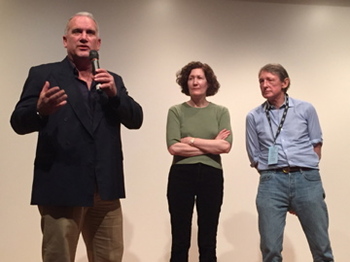Tiger Tiger (George Butler, 2015): USA, Bangladesh, India
Reviewed by Phill Hunziker, Viewed at the Santa Barbara Museum of Art, part of the Santa Barbara Film Festival 2015.

I remember reading and learning about tigers when I was growing up. They always were cool cats to me, second to only the mighty lions. Their prominence in culture and art cannot be ignored. That’s why it kills me to now know the truth about them. Tigers are going extinct and there’s not enough hope in saving them. This documentary sheds light on this topic in a way that not only makes you feel for the tigers, but also feel for those who share their lives with them.
Dr. Alan Rabinowitz, one of the most famous tiger conservationists, travels to the Sundarbans, a dangerous forest that spans across the India-Bangladesh border, to explore the reality of both the tigers and the humans who coexist with them. The Sundarbans is home to the largest wild population of tigers in the world, making this a prime target for poachers. Oh, another thing: Dr. Alan has leukemia.
From the beginning, it is clear that Alan is the perfect person to lead the audience through this journey. He has over 25 years of experience in this field. Additionally, he is extremely insightful, intelligent and you can just tell that he truly, 100% cares about helping the tiger population by any means. He has a great personality that instills trust. He guides you threw a story that covers everything: the human’s side, tiger’s side, history, culture, politics; everything. The story, characters and subject are so interesting and powerful that the filmmaking techniques themselves (cinematography, sound, etc.) don’t need to fluff this up. There’s superb editing and shots, but they’re not as integral to making a great film as they would be with a far less compelling story.
There are many documentaries that, even if their makers insist otherwise, tend to be very one-sided. Such is not the case with this one. The sides of both the tigers and humans who coexist with them are both equally portrayed. Also, while there is a more one-sided viewpoint towards the government, regulators, poachers and enforcers, the film still understands that there are no clear-cut, black and white situations.
That last part is what separates this documentary from the pack. Alan even discusses it in the film; there are no black and white answers or reasons. There are many moving parts in this problem and it is going to take a lot of cooperation, education and collaboration to be able to move forward in a positive direction. That being said, humans are the only ones who can fix this; we need to. Our survival, not just the tiger’s, is dependent on it. For more information, go to Tigertigerfilm.com.
“As bad as we treat human beings, other animals virtually have no rights.”
“The only true danger to the tiger’s survival is man.”
About this entry
You’re currently reading “Tiger Tiger (George Butler, 2015): USA, Bangladesh, India,” an entry on Student Film Reviews
- Published:
- 02.17.15 / 12am
- Category:
- Films, Santa Barbara Film Festival 2015
3 Comments
Jump to comment form | comments rss [?]